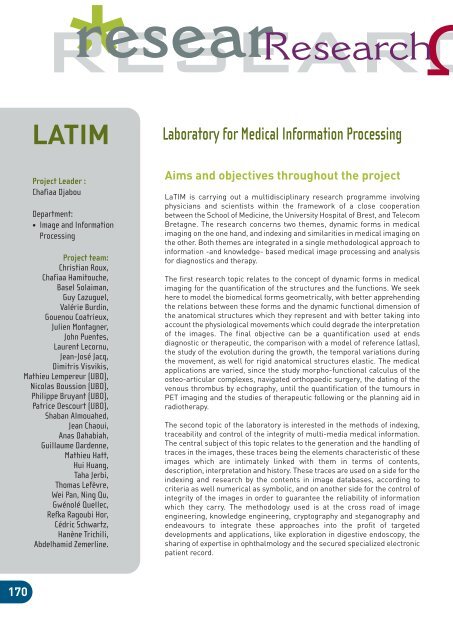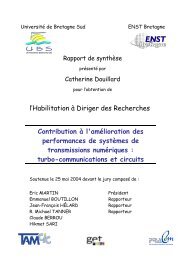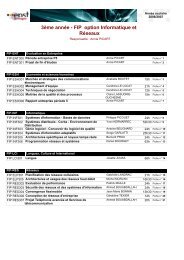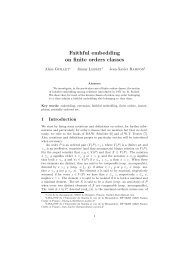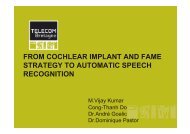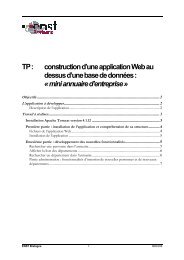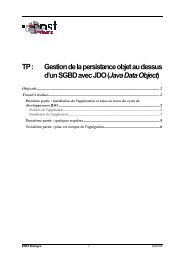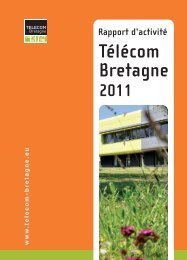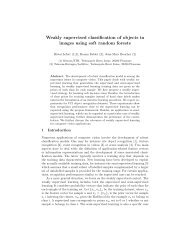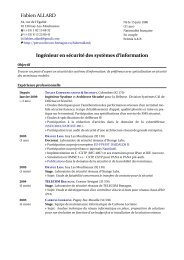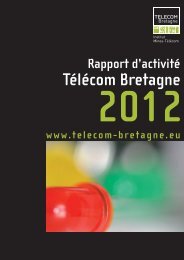researResearch - Télécom Bretagne
researResearch - Télécom Bretagne
researResearch - Télécom Bretagne
You also want an ePaper? Increase the reach of your titles
YUMPU automatically turns print PDFs into web optimized ePapers that Google loves.
esearc<br />
<strong>researResearch</strong><br />
LATIM<br />
Laboratory for Medical Information Processing<br />
Project Leader :<br />
Chafiaa Djabou<br />
Department:<br />
• Image and Information<br />
Processing<br />
Project team:<br />
Christian Roux,<br />
Chafiaa Hamitouche,<br />
Basel Solaiman,<br />
Guy Cazuguel,<br />
Valérie Burdin,<br />
Gouenou Coatrieux,<br />
Julien Montagner,<br />
John Puentes,<br />
Laurent Lecornu,<br />
Jean-José Jacq,<br />
Dimitris Visvikis,<br />
Mathieu Lempereur (UBO),<br />
Nicolas Boussion (UBO),<br />
Philippe Bruyant (UBO),<br />
Patrice Descourt (UBO),<br />
Shaban Almouahed,<br />
Jean Chaoui,<br />
Anas Dahabiah,<br />
Guillaume Dardenne,<br />
Mathieu Hatt,<br />
Hui Huang,<br />
Taha Jerbi,<br />
Thomas Lefèvre,<br />
Wei Pan, Ning Qu,<br />
Gwénolé Quellec,<br />
Refka Ragoubi Hor,<br />
Cédric Schwartz,<br />
Hanène Trichili,<br />
Abdelhamid Zemerline.<br />
Aims and objectives throughout the project<br />
LaTIM is carrying out a multidisciplinary research programme involving<br />
physicians and scientists within the framework of a close cooperation<br />
between the School of Medicine, the University Hospital of Brest, and Telecom<br />
<strong>Bretagne</strong>. The research concerns two themes, dynamic forms in medical<br />
imaging on the one hand, and indexing and similarities in medical imaging on<br />
the other. Both themes are integrated in a single methodological approach to<br />
information -and knowledge- based medical image processing and analysis<br />
for diagnostics and therapy.<br />
The first research topic relates to the concept of dynamic forms in medical<br />
imaging for the quantification of the structures and the functions. We seek<br />
here to model the biomedical forms geometrically, with better apprehending<br />
the relations between these forms and the dynamic functional dimension of<br />
the anatomical structures which they represent and with better taking into<br />
account the physiological movements which could degrade the interpretation<br />
of the images. The final objective can be a quantification used at ends<br />
diagnostic or therapeutic, the comparison with a model of reference (atlas),<br />
the study of the evolution during the growth, the temporal variations during<br />
the movement, as well for rigid anatomical structures elastic. The medical<br />
applications are varied, since the study morpho-functional calculus of the<br />
osteo-articular complexes, navigated orthopaedic surgery, the dating of the<br />
venous thrombus by echography, until the quantification of the tumours in<br />
PET imaging and the studies of therapeutic following or the planning aid in<br />
radiotherapy.<br />
The second topic of the laboratory is interested in the methods of indexing,<br />
traceability and control of the integrity of multi-media medical information.<br />
The central subject of this topic relates to the generation and the handling of<br />
traces in the images, these traces being the elements characteristic of these<br />
images which are intimately linked with them in terms of contents,<br />
description, interpretation and history. These traces are used on a side for the<br />
indexing and research by the contents in image databases, according to<br />
criteria as well numerical as symbolic, and on another side for the control of<br />
integrity of the images in order to guarantee the reliability of information<br />
which they carry. The methodology used is at the cross road of image<br />
engineering, knowledge engineering, cryptography and steganography and<br />
endeavours to integrate these approaches into the profit of targeted<br />
developments and applications, like exploration in digestive endoscopy, the<br />
sharing of expertise in ophthalmology and the secured specialized electronic<br />
patient record.<br />
170


